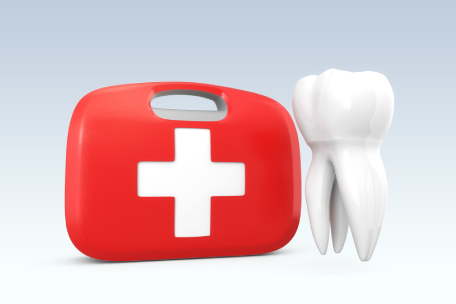Discovering a problem in your mouth can be worrying, especially when it’s hard to check it yourself. As someone without dental training, figuring out if it’s an emergency or something you can handle at home can be tricky. Sometimes, you can ease the discomfort with basic home remedies, but there are situations where calling your dentist right away is important.
In this blog, we’ll talk about 8 common dental emergencies and situations where you might need urgent help. Even if we try to keep our teeth healthy with regular check-ups, unexpected issues can still pop up, causing discomfort and confusion. Learning about these common dental emergencies will help you respond appropriately and get professional help when necessary to protect your oral health.
Treatment Length
Invisalign
As short as 6 months, with an average of 12 to 18
Braces
Average of 12 to 24 or more, depending on the type and severity of malocclusion
Can treatment be expedited?
Invisalign
Wear aligners for 20+hours a day, keep teeth and aligners clean, visit the dentist regularly to monitor progress
Braces
Visit the clinic as directed for adjustments, keep teeth and brackets/wires clean and free of plaque, avoid habits that could increase treatment time
Cleaning
Invisalign
Use a soft-bristled toothbrush and non-abrasive toothpaste to gently scrub aligners
Braces
Use an interdental toothbrush and water flosser to remove plaque and bacteria from around brackets and wires
Maintenance
Invisalign
Keep teeth and aligners clean for best results
Braces
Keep teeth and brackets/wires clean for best results
Removable?
Invisalign
Yes, aligners are designed to be removed while eating/drinking and while brushing/flossing teeth
Braces
No, traditional braces cannot be removed until treatment is complete, and the dentist is the only one that should remove them
Visits to dental clinic
Invisalign
Periodically, you need to visit the dental clinic to monitor your progress
Braces
Yes, you will need to visit the clinic every few weeks as teeth shift for adjustments
How much does it cost?
Invisalign
Starts at approximately $1,500 for up to 5 aligners and goes up to around $8,000 for unlimited aligners
Braces
Costs an average of $3,000 to $5,000+, depending on several factors
Benefits
Invisalign
Virtually invisible
Comfortable
Convenient
Braces
Does not require compliance- once braces are attached, they are not removable except by the dentist upon completion of treatment
Ideal for
Invisalign
Mild to moderate malocclusions, can be used for more severe along with attachments, depending on the type of malocclusion
Braces
Mild to severe malocclusions
Common Dental Emergencies
Toothache
One of the most common dental emergencies is a toothache, caused by various factors like tooth decay, gum disease, or a cracked tooth. The pain could be mild to severe, constant, or intermittent. It’s crucial to see a dentist promptly to diagnose and treat the problem.

Chipped or Broken Tooth
Another dental emergency is a chipped or broken tooth, particularly if it’s broken down to the gum line. This exposes the tooth’s pulp, containing nerves and blood vessels. If the pulp gets infected, it can lead to pain, swelling, and even tooth loss. Immediate dental attention is necessary in such cases.
Knocked-Out Tooth
If a tooth gets knocked out, take immediate action to save it. The sooner you reinsert the tooth into its socket, the better its chances of survival. If reinsertion isn’t possible, store the tooth in milk or saliva until you can see an emergency dentist.
Lost Filling or Crown
Broken Orthodontics
Having braces or other orthodontic appliances can lead to emergencies if they break or become loose. In addition to disrupting your treatment progress, broken orthodontic appliances can make eating, speaking, and maintaining oral hygiene challenging.
Dental Abscess
A dental abscess, characterized by a collection of pus around a tooth, can cause intense pain, swelling, redness, and even fever. To prevent further complications, it’s essential to seek prompt dental care if you suspect a dental abscess.
Bleeding and Pain After a Tooth Extraction
It’s common to experience bleeding and discomfort following a tooth extraction. However, if the bleeding persists heavily or doesn’t cease after a few hours, or if the pain becomes intense, seeking dental attention is crucial as it may indicate a lack of blood clot formation.
Swelling or Discoloration of the Gums
Noticing swelling or changes in the color of your gums could indicate a dental infection. It’s important to schedule a dental appointment immediately if you observe any swelling or discoloration in your gums. Early diagnosis and treatment can stop the infection from spreading to nearby areas.

What Should We Do During a Dental Emergency?
It’s important to stay calm and take prompt action during a dental emergency. Here’s what you should do:
Assess the Situation
Evaluate the severity of the emergency. Determine if there is bleeding, pain, swelling, or damage to teeth or dental appliances.
Contact Your Dentist
Follow First Aid Measures
If case of bleeding, apply gentle pressure using a clean cloth or gauze to control it. Use over-the-counter pain medication to alleviate discomfort if necessary.
Handle Knocked-Out Teeth Carefully
Hold the knocked-out tooth by the crown (top) and don’t touch the root. Rinse it with water if it’s dirty, but do not scrub it. Until you can visit a dentist, try to put it back into the socket or keep it in milk or saliva.
Protect Damaged Teeth
Use a cold compress to minimize swelling, and rinse your mouth with warm water if you have a chipped, fractured, or broken tooth. Avoid chewing on the damaged tooth, and see your dentist immediately.
Manage Pain and Swelling
Use ice packs or cold compresses on the outside of the mouth to reduce swelling and relieve pain. Pain relievers can also help alleviate discomfort.
Follow Dentist's Instructions
Follow any instructions given by your dentist for managing the emergency until you can receive professional care. Attend your dental appointment promptly for proper evaluation and treatment.
Manage Common Dental Emergencies with Avery Dental Center in Dublin, Ohio
Understanding common dental emergencies is crucial for maintaining oral health and responding effectively to unexpected situations. From toothaches to knocked-out teeth, being prepared makes all the difference in preserving your dental well-being. Remember, swift action and seeking professional care from your dentist can help alleviate pain, prevent further damage, and promote swift recovery in dental emergencies.
New patients can reach out to Avery Dental Center in Dublin, Ohio, at 614-683-9557 to schedule an appointment and address any dental emergencies promptly. Existing patients can contact us at 614-789-9000 for immediate assistance. Don’t wait until it’s too late – prioritize your dental health today.
FAQs
What should I do if I have a toothache?
If you experience a toothache, rinse your mouth with warm water and gently floss to remove any debris. Contact your dentist to schedule an appointment for proper evaluation and treatment.
What should I do if my tooth gets knocked out?
If a tooth gets knocked out, handle it carefully by the crown, rinse it with water if dirty, and try to reinsert it into the socket. If not possible, store it in milk or saliva and see your dentist immediately.
How should I handle a broken orthodontic appliance?
If you have a broken orthodontic appliance, such as braces, contact your orthodontist for guidance. Avoid manipulating the broken appliance and follow any instructions your orthodontist provides until you can receive professional care.











